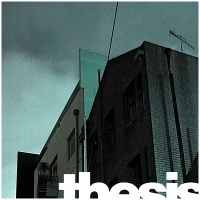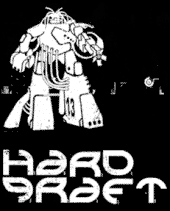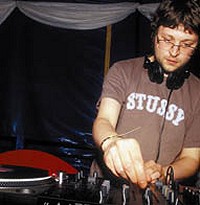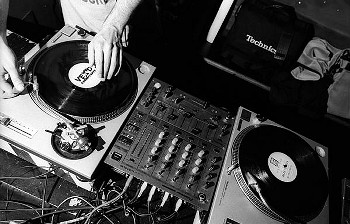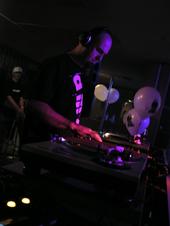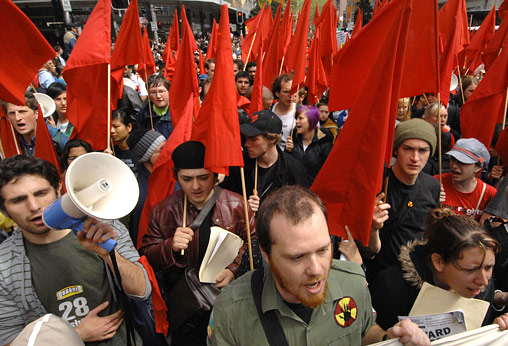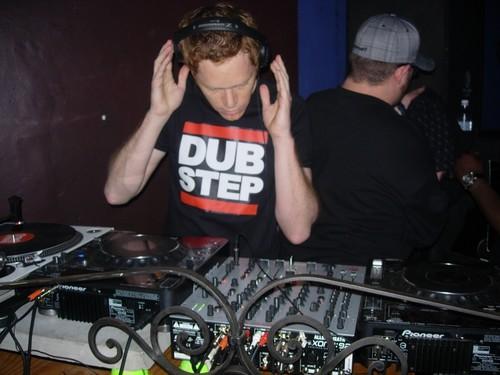Down at the corner of King Street and Enmore Road, Newtown, where Rhyece O’Neill from Western Synthetics lives, or at the Laundry on Johnston Street, Fitzroy, with Spherix on the decks, dubstep is carving out a different shape to its UK counterparts.
There are no dubplates or pirate radio sessions to drive the sound’s progression. There are less parties in Australia, less media coverage, and less access to the pivotal UK producers. It’s no outpost though. DJs, producers and listeners – everyone’s active here – are creating unique, local culture around dubstep in Brisbane, Melbourne, Byron Bay, Perth, Adelaide and Sydney.
The limitations of distance and infrastructure are a key influence, the mode of production is another. Personal computers are used to produce most dubstep, and there is a lot being produced. So it makes sense that producers and DJs so far from Europe’s pressing plants are bypassing vinyl and using ‘320s’ – shorthand for 320 kbps audio rate music files – to trade with club and radio DJs and other producers.
Is there an Australian sound? Is technology part of it? Instead of vamping on the topics, Cyclic Defrost went direct to some of the key people shaping the scene. Here’s their take.
fliPPo (Dave Phillips)
DJ/producer – Melbourne
I’ve been trading 320s for about a year or so I guess. The response is pretty good. Some DJs and producers will have a good chat to you about them, ask if they can pass them onto label contacts they might have, or play them out at clubs and on radio. Others you may not hear back from, but the tracks still turn up on their radio shows, or you hear from other people that they were played out at parties.
320s are very important for dubstep. It’s the whole grass roots vibe and one of the things I love about the scene. It’s a natural progression from dubplate culture. Obviously they’re not as sexy and exclusive as a plate, but for a relatively web-centric scene like dubstep with punters spread thin over the globe, it works. Most producers will hand out to nearly everyone in their local scene, and a handful of contacts internationally, what you end up with is pockets of sound in various cities, but still with healthy global cross-pollination. I love the fact that I can go to Bass High at Laundry and hear Spherix play tracks of his own, mine, all the other guys from Melbourne and Sydney, and fresh bits from all over the globe. I love that Garage Pressure can open on a Friday night with four tracks from Australian producers, all tunes that were finished that week.
It’s all very casual and DIY. A couple of times I’ve finished off mixing down a track on the laptop in bed, rendered and emailed a 320 to the other side of the world, and then heard it in the mix just hours later whilst tuning in to SUB FM at work in the morning, that’s pretty funny. Basically, you are hearing the sound evolve in front of your eyes from week to week, without release dates, distribution logistics and label managers’ tastes filtering and slowing the process.
Thesis (Theo Howard)
Producer/designer – Melbourne (but living in the Netherlands)
One of the things I love about dubstep is that the scene is very approachable. This means that it’s very easy to make a transition from listener to active participant. For example, fans trying their hand at production or DJing. It seems like a large proportion of dubstep fans (more than most other forms of music) are involved on that higher level, or at least know someone who is.
With Australian cities being so far apart, the internet is a godsend. I make 320s of my music available to DJs and influential producers, and most producers return the favour. When I first began releasing my music this way, I gave it to anyone who took an interest. Now that my music is gaining momentum, I’m more selective. To the best of my knowledge (and hearing), 320 kbps mp3s are indistinguishable from a true lossless format unless they are considerably slowed down or otherwise manipulated. The proliferation of 320s in a scene obsessed with sound quality is testament to this.
The UK scene, being the birthplace of dubstep, is much larger than the Oz scene. Maybe it’s my imagination, but lately I’ve noticed I’m picking up a certain sound, an earthy and open style in Australian dubstep which makes it unique. In the last six months, I’ve been approached by a few labels, and I have tracks on two compilation CDs out in 2008, and a strong possibility of a 12 inch release.
Frosty (Adam Frost)
DJ/promoter – Brisbane
When I first came across Benny Ill, Oris Jay, Kode9 and Zed Bias, as well as labels like Texture, Soulja, Vehicle and Shelflife, it was pretty much the same feeling I had when I first heard jungle 10 years earlier. A couple of years later, I began promoting a night in Brisbane called >Hard graft>> with Fraser Farrell and Tommy RO from community radio station 4ZZZ.
The Oz dubstep scene began its second phase in 2006. Skream and Kode 9 lectured at the Red Bull Music Academy in Melbourne, which gave it a push down south, as tours held before then were only viable in Brisbane and Sydney.
Jabba [Moving Ninja] leads the way in Australia, production-wise, with two quality releases on Pinch’s Bristol label Tectonic. In Brisbane, Nam Shub of Enki dabbles on the more agrressive side of things and Victor Xray works with the stripped down minimal sounds. There are a few other Aussie producers making waves. It’s probably too early to say, at this stage, but what I’ve heard of Western Synthetics sounds promising.
However, when it comes to 320s, I don’ think I am ready to let myself be bound to using a laptop in my sets yet. You have to be right on the eq. The snare is way too harsh sounding, the bass is not full enough, and compressed files do not sound very good over a system, particularly with this music. And it makes mixing very difficult because you’ve gotta really be fucking with the gains and highs. I prefer vinyl.
Garage Pressure (Farj)
DJ/promoter/label – Sydney
How many of the local DJs who play dubstep have actually been to Forward or DMZ and know what the sound is actually about? It’s great to be passionate about a sound and a lot more people are playing dubstep, but if you are talking about the scene and who locally is making an impression – it has to be the producers and labels that are engaging the world.
For example, we brought Moving Ninja from Homebush in Sydney into a scene driven by wobbly bass and a bunch of kids from Croydon. I personally went to the UK almost every year since 2000 and handed CDs out and spoke to the rising dubstep labels before Jabba [Moving Ninja] got signed – it has been a long time passion.
MP3 sound quality is good enough for Australian sound systems (320K), but it’s not good enough for bigger rigs (120db+ undistorted sound with headroom) on the systems you get in the States, UK and Europe – where you must wear ear plugs. We use Serato as it’s the most stable and best sounding; we use wav for vinyl we record and CDs we receive. MP3s are for online transfers for speed, but we usually get WAVs regardless, either digitally or later recorded off vinyl.
Everything we do is geared to a global audience and global influence, even FBI (Sydney community radio) with the online stream. Local events for us are about capturing and initiating trends – it always has been since our first “dark garage’ night DarkSyde in 2002 where Australian dance floors first heard the tracks from artists such as Benga and Skream that are now massive.
If you want to write the definitive piece we have to do a detailed interview, because practically every first for dubstep, grime and underground garage in Sydney (and possibly Australia), we were first to do. But it’s not all about us, there are a tonne of guys we are working with in different capacities (production wise, on events and tours and label) that are coming through the ranks that we are supporting and collaborating with.
Mark Pritchard
DJ/producer – Sydney
I started hearing the more bassline, stripped back versions of UK garage around 2001. I was more of a broken beat DJ, but apart from Cousin Cockroach’s ‘This Aint Tom and Jerry’, IG Culture’s stuff and Seiji, I found a lot of the music a bit light, and used to play broken beat alongside early Tempa and Oris Jay 12s. The scene seemed to dip for a while and then I was caught up in moving to Australia.
On a return trip to Europe a couple of years ago, I started to hear some of the second wave of dubstep like DMZ, Skream and Benga and I was blown away. I know these guys had been plugging away for a while but I missed out as the records didn’t reach Australia in any great quantity.
The thing that really got me excited was, and is, the potential of the music to soak up lots of vibes. It reminded me of when breakbeat and jungle started out – you can have dark stuff and musical stuff and ragga jump-up type influences and techno or house and whatever really. Dubstep has the same openness at the moment. You can have some heavy bass up Skream track next to deep Kode 9 stuff, then some more edgy Planet Mu release and then some half-step Coki tune.
As the focus comes onto the scene, a lot more people are making the music, which can be a good thing. But people fresh to the scene sometimes emulate other dubstep tunes instead of making their own stamp. Same thing happened with drum “n’ bass, eventually you got people that listen to a Calibre track and then try and make a track like that, which is the opposite to what Calibre does. He listens to house, techno, hip-hop, broken beat, dub reggae, and I’m sure lots of other music, then makes a track inspired by that. So his tracks have a unique vibe and that’s what it’s all about. Sure you can be inspired by new productions but put your own shit in there.
Void (Damien)
DJ/promoter – Sydney
I first heard dubstep at a Garage Pressure night back in 2003. I wasn’ sold straight away, to be honest. The few tunes that did attract me were kind of a strange revival of the early techstep drum and bass style (early Ed Rush & Nico, early No-U-Turn); cold minimal and dark, growling synths, at half the speed and heavily influenced by garage. I wasn’ blown away, but it was enough to get me to dig deeper to see what else was out there.
I got into the stuff out on Destructive at first; artists like Distance, Darqwan and Vex’d that had the feel of other genres I was into at the time. Nic and I were showcasing more extreme elements of IDM, breakcore, jungle and heavy drum’n’bass at our nights. I returned from a two-year stint in Europe and we started Void, attempting to merge our growing appreciation of dubstep and grime with our other interests, predominantly IDM.
The scene is developing pretty evenly throughout the major cities [in Australia]. From where I stand, Sydney and Melbourne are the most vibrant, with Void getting great turnouts and a weekly Sunday night going on in Melbourne. I suppose that can be attributed to the diversity of the scene. The artists, DJs and punters have backgrounds in jungle and drum’n’bass, garage, dub and techno. Whatever night you go to around town, I can guarantee you will not hear dubstep all night.
Almost all the DJs here are involved in production. They seem more experimental, more willing to try new things, beat structures, influences. No doubt this has a lot to do with not needing to make a big track every week or two and maybe even a bit to do with a bit of the Aussie, “Fuck it, I’m doing it my way attitudeâ€. In any case the local guys definitely have a different vibe, that’s less dancefloor-oriented than most UK stuff.
Spherix (Josh Lamaro)
DJ/producer – Melbourne
I love old dub reggae stuff like Scientist, Prince Jammy and King Tubby, but I came from a drum ‘n’ bass production background, working solo and with Catacomb in the past. I got into dubstep because I enjoy the spatial element as opposed to tech d’n’b where I’m cramming millions of sounds in to make a tune. Dubstep allows less elements, but with just as much emphasis on technicality.
I haven’t witnessed any dubstep in the UK, so I can’t say how it compares, I just know they have a lot better sound systems there that are capable of showing dubstep for what it really is about. The Australian scene has a close knit community. It’s still very small, so you tend to only find cats that are into the music at the parties, and some friends of said individuals.
If you want to throw your tracks all over the internet for self exposure you can do that. It can work two ways: catch attention by keeping it exclusive to big name guys who play it out and on radio. I don’t think digital music takes vinyl labels out of the picture, it only cuts out the record label if you’re ‘distributing’ signed material that is slated for release, or shooting yourself in the foot by giving everyone a free 320 then expecting it to be signed/released when everyone is already sick of it, and has a copy.
There is plenty of interest in Australian dubstep at the moment though, and release offers are coming in steadily, I’ve recently signed three tunes to Baredubs Records in London.
Western Synthetics (Rhyece O’Neill)
DJ/producer – Sydney
I don’ have a nationalistic pride in what I’m doing musically, but I do think there is a distinct sound coming out of this part of the world. A lot of tracks have a very South-Pacific flavour, and a lot of the dubstep producers in Australia and NZ are doing vastly different stuff to what’s coming out of London. There are less than 20 producers here, about the same in DJs and fuck all gigs. Everyone basically knows each other, but the thing is that nobody in the UK is making tunes like the crew here. I like to think that the very reason I get played is precisely that I’m not trying to sound like Skream or Benga (as much as I love them).
I had recently moved to Sydney from Melbourne and was out of work – I was producing a lot of dub and jungle, while also busking down at the Newtown station playing Dylan and Neil Young covers to get extra cash – and it was largely local guys like fliPPo, Spherix and Moving Ninja that made my ears prick up. fliPPo, in particular, his stuff is so different from everyone else. It was just a slap in the face!
I trade 320s all the time. It’s kind of like the whole basketball card thing when you were a kid. If there is a producer who has a card (dub) you want it’s as simple as hitting him/her up on Myspace or via the dubstep forum for a swap. I have been getting a fairly good response from DJs, like I get fairly regular spins on Rinse FM, Reload radio, Sub FM and FBI. The biggest buzz to date was having Distance rewind one of my tunes on his Rinse FM show.
320s do the job, you can send them to your mates in Estonia and Texas and they still sound good on a big system. A wav is preferred, but the ultimate is still wax. But there is no dubplate culture in Australia because there are no cutting engineers doing dubplates, and personally I would not be able to afford to participate even if there was.
Jayar (Julian Rutt)
DJ/promoter – Adelaide
I stumbled upon dubstep by downloading a mix posted on the Adelaide drum ‘n’ bass forums. I loved it from the outset. I’m into dub as well, so dubstep wasn’t a big leap. Dubstep is kind of where I hoped breaks might go years ago. I just leapt headlong into buying tunes, playing it out, getting back into promoting shows and trying to expose other people to it in any way possible.
It’s a bit more isolated [in Australia], given the geographical distances between the cities, and it’s obviously more focussed on the UK where the scene started. My experience is limited having not seen any interstate DJs play, but AC23 and the guys behind the Sunday nights at the Laundry in Melbourne, and Farj and Garage Pressure have been fairly instrumental in getting the sound out there and arranging touring DJs. Adelaide’s Attache (Son of Sam) was making dark garage and dubstep before plenty of people had even heard of it.
The old days of d’n’b dubplates are basically gone in favour of cheaper CDs, so it is interesting seeing the dubsteppers cutting acetate and the analogue low frequency debate rearing up again. I’m a vinyl junkie and have never liked the feel of CDJs, but I will play something that way if it’s the only option available. As far as MP3s go, watch this space, I’m only just now getting things on 320 that I’d actually want to play at upcoming shows.
Having been a drum “n’ bass DJ for nearly 10 years and watching that scene unfold, it will be interesting watching what happens with dubstep… It’s growing in popularity at an extremely rapid rate that could easily implode if the ideas and sounds stagnate. Though with the sound still noticeably evolving on an almost daily basis, I’d say that’s a pretty unlikely scenario.


